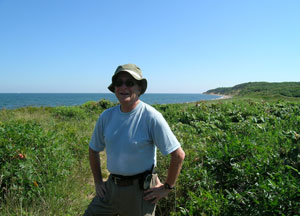Sabotage on the Woodland Trails: Markers have been cut out of trees and paths carved by dirt bikes

"Where's the trail?" asked Ken Kinder as he walked on Tuesday afternoon through the woods in Southampton, into an overgrown clearing and past a sandy oval rut - a makeshift track carved by dirt bikes and all-terrain vehicles.
He searched for the markers that Southampton Town uses to delineate trails - in this case, blue owl blazes. Often, he found only nails where the blazes had once hung. The trail itself has been cut by new paths created by the motorized vehicles.
"Dirt bikers like to go straight down the hill. It's more fun," Mr. Kinder said.
The carefully plotted trail, which is just two years old, was harder to see than the improvised path of the vehicles. "Where's the trail?" he repeated.
The noise of motorized vehicles, including A.T.V.s and dirt bikes, and the damage they cause on trails in East Hampton and Southampton Towns have led to a variety of protests and actions by trail advocates and residents.
Residents whose properties abut trails, including the Paumanok Path, which runs from Rocky Point to the Montauk Lighthouse with interruptions in Southampton, have complained to the towns, and some have alerted local trails preservation societies. In response, the societies have installed more signs, saying that such use is prohibited, and have stepped up their trails surveillance.
Some residents have erected barricades and painted over or pulled down trail markers. Now, no one can navigate the trails, including the hikers, bicyclists, and horseback riders for whom the Paumanok Path and accessory trails were intended.
In East Hampton, damage from A.T.V.s has been greatest in Laurel Canyon in Montauk, but effects can be seen in other places where trails are wide enough to accommodate the vehicles. "At Culloden Point, kids riding A.T.V.s rode right by us as if we were not there," said Steve Tamber, president of the East Hampton Trails Preservation Society.
Mr. Tamber said that abuse of the trails leads to irreparable erosion and unsafe conditions. In some cases, he said, the town has erected fences. Nature preserves have been chained off at night so that "cars and trucks don't make a mess of the place."
Mr. Kindler, a Sayville resident who is secretary of the Southampton Trails Preservation Society, is working to complete the Paumanok Path as well as to ensure its sustainability. He said that fines need to be higher. "The damage is spreading like a cancer, and everywhere I look there is a new store retailing these nightmares on wheels."
Off-road vehicles such as dirt bikes and A.T.V.s are not allowed on public lands whether they are owned by the state, county, or town. The county's fine is $500. The state will fine anywhere from $75 to $250 if the vehicle is registered. If not, they will impound it and issue a summons. Southampton Town's fine is $250 and in East Hampton, the fine depends on the specific charge. Southampton is considering raising its fine.
Richard Lupoletti, a member of the East Hampton Trails Preservation Society who lives in the Buckskill area, said, "The problem with all of this is no enforcement. . . . Nobody seems to think that it's important."
"If there's no enforcement, kids know, and it makes it very difficult to stop," Mr. Tamber said. "They ride with impunity. The town doesn't have enough resources to put people in its park land."
One East Hampton resident has called for the town either to build an A.T.V. park or to provide transportation to parks farther west.
Mr. Tamber said that the preservation movement is a victim of its own success. "We've created so much parkland there's too much to cover." The town has 45 miles on the Paumanok Trail, 250 miles in all, with connecting trails included. "You have to be in the right place at the right time," he said.
Southampton Town alone has spent millions in Community Preservation Fund money to buy land for open space, including some areas specifically targeted for trails to help complete the Paumanok Path.
The town recently named an ordinance inspector for code enforcement on Community Preservation Fund properties. Ron Carter, a nine-year veteran of code enforcement, was named to the position five months ago. Although the townwide area he covers is vast, Mr. Carter is focusing on the Long Pond Greenbelt in Bridgehampton and the area around Tuckahoe woods where residents have reported off-road vehicle activity.
The difficulty is in catching the drivers. Mr. Carter said that while he is on foot, he cannot chase down those that will not stop for him. He said that in Southampton, the violators are a mix of teenagers and adults. The one person Mr. Carter has captured was a 43-year-old man from New York City. "He knew better," Mr. Carter said.
People who live alongside the trails have complained to town officials about noise and property destruction. They also worry that recent dry weather will create conditions in which an errant spark could cause a brush or forest fire.
In some cases there have been attempts to vandalize or sabotage the trail system. Not only have blazes been pulled from their nails, but those painted on trees have been cut completely out of the bark, forcing those who maintain the trails to repaint them.
In North Sea, a farmer's deer fence now blocks off part of the Paumanok Path. Mr. Kindler has seen other makeshift barricades in the woods off of the Bridgehampton-Sag Harbor Turnpike, in the same area where the blazes have been cut out.
If residents think that they are deterring hikers from traveling through their neighborhoods, they are misguided, Mr. Kindler said. When the hikers cannot follow the trail, "there will be a bunch of people wandering around where the trail is broken," trying to find their way back onto it. "It really defeats the purpose," he said.
